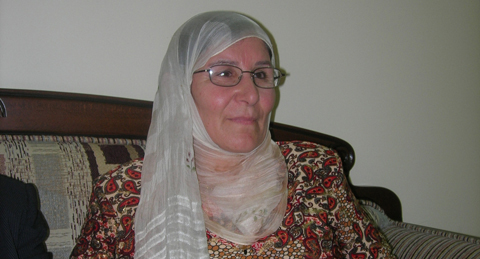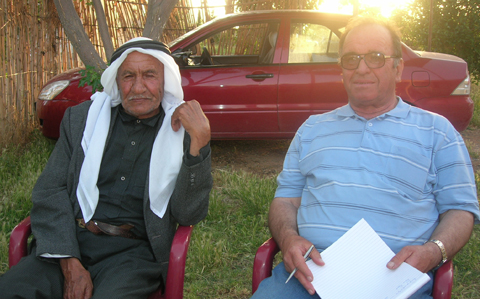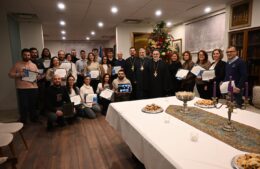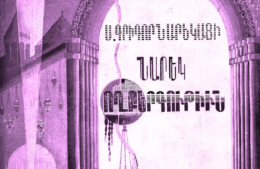The Armenian Islamic Tribe in Syria
- (0)

By Kevork George Apelian
Translated and abridged by Vahe H. Apelian

We depart from Kamishli to visit our companion’s, Dr. Garo Hekimian’s, Kurdified nephew, Mehran Hekimian. The road is long but is straight and makes for a smooth ride. The road going from Kamishli to Ras al Ein runs parallel to the Syrian-Turkish boarder. At times it approaches the border so much that the facial expressions of the Turkish soldiers standing on guard on the towers become visible. A barbwire separates the two countries.
Once in a while, along the road, we see young girls who are walking in the barren vast expense.
-’’Don’’t they go to school, asks Annie?’’ Annie is my niece. We are travelling in her husband’’s- Tom’’s – car. My wife also is accompanying me.
-’’Of course they go. However, after school they work in the fields to pull the plants and collect the lentil and the beans’’, replies the doctor.
The comfort in the car contrasts sharply with the scorching desert of this inhospitable terrain. Through these vast expanses almost a century ago my compatriots walked. Hungry, thirsty, bare-footed and emaciated, how did they manage to walk? Those who were massacred in Ras al Ein were done for, the survivors were herded to out far to Der Zor for their final reckoning. How fortunate are the girls we see outside every now and then gathering lentil or bean. They at least have shoes and are not starving and are not emaciated.
We pass through large and small villages.
-’’Here in this village there are also Kurdified Armenians’’, notes Dr. Garo.
What is there to say or do? What Armenian in these places, isolated from the rest of the world, almost forgotten? I wonder. Their forbearers were forced to abandon their beautiful country and settle here. Of course the Armenian settlers here were fortunate. Others had not the opportunity to remain alive.
-’’This is the Amouda village or city like settlement. There are a number of Armenians here as well’’, says Garo.
After driving for a considerable period of time we arrive Ras al Ein. We have been toldthat there is a noted restaurant here, Restaurant Serop. I had been in touch with the man and I was told that he has interesting stories to tell about his father. The man had not volunteered to tell us. We also had neither the heart nor the time to dine. We headed Dr. Garo’’s nephew, Mohammad (Mehran) Mahmoud’’s house.
The tall statured Mahmoud invited us in. The foreign car had aroused the interest not only of the neighbors and the lads on the streets, but also of the surrounding at large. The host had assured everyone that we were not harmful people. We stepped in, into a long and large hall with twin divisions. The “eastern” side was furnished with pillows and cushions and the “western” side was furnished with armchairs. Hardly had we stepped in we noted, to our great surprise, a wooden bust of King Trdat, an Armenian tricolor scarf, and few other Armenian pictures. What are these artifacts doing in Kurdified Hovhannes Hekimian’’s son – Mahmood’’s – guest room, I wonder.
There is a bit of a dismissive smile on Mahmood’’s face, at the site of our puzzlement.
-’’Our blood is Armenian blood’’, he emphasizes.
He wants to know the purpose of our visit. His nephew, Dr. Garo, had already explained to him. However, he wanted to hear from us. I explain. He shakes his head.
-’’I am glad you came, for no one is interested in us. Not the government of Armenia or the Armenian Church. We are people who live on social margin. The Armenians do not accept us, nor do the Kurds. We applied to the Government of Armenia, but nothing happened. You have come out of interest in us, we are thankful.’’
I gift him a copy of my book’’s, titled “Martyrdom for Life”, Arabic translation.
-’’This is our Salman Derbo!’’ – exclaims Mohammd Mahmood.
-’’Do you know him?’’ I ask.
-’’Of course. His son lives here’’ clarifies Mohammad.
He arranges to call a neighbor’’s wife who enters the room and sees the book’’s cover and is totally amazed.
-’’This’’, she says pointing to the picture on the book’’s cover, ‘’is my grandfather, Salman Drbo. Each and every home of our extended family has this picture hanging on a wall.’’
Her father, Khalaf is away. He is the son of Hadjentsi born Aram Keklikian, turned Bedouin Chief named Salman Drbo who is a cousin of the famed Armenian American orthopedic doctor who treated a young soldier named Robert Dole. I autograph and gift a copy of the book to give to Aram’’s, that is to say Salman Drbo’’s son, Khalaf, and hand the book to his daughter. She is very happy. She stays with us throughout our visit. It is evident that she is pretty liberal minded. She shakes hand with the men and speaks freely.
-’’Ya Mahmood’’ I say, ‘’we have come to gather information about people like you. What do you have to tell us about your father?’’
-’’Whatever I know, I will tell you, says Mohammad Mahmood. My father, Hovhannes Hekimian, was from Geghetsi village of Moush. He was born in 1908. We were told that he had two brothers, named Anto and Avedis. He had two sisters, Srpouhie and Azniv. My father was forced out of Moush and was brought here where he remained. He was a kid in those days. He was named Ebrahem and settled in Meyrkez where he married a Kurdish woman named Khamsa. They have four daughters and four sons. I am the eldest of them. My brothers live in this area. I will take you to our village Meyrkez. I came and settled in Ras al Ein to educate my sons. There is no school in Meyrkez.
-’’Mahmood, how many children do you have? I ask
-’’I have 5 sons’’, replies Mahmood. ‘’Thank Allah. The eldest is Ebrahem or Apraham. He left the area and went to Europe and settled in Holland. He converted to Christianity there. The whole family was baptized. The names of his sons, my grandsons, are Sevag and Daron. Hence he cannot come to these areas any more. You know, he became a Christian.’’
‘’My other son is Emir. He has four beautiful daughters. The third is Akram. We call the fourth Ayden. However, he is Vrej. My last son is Arman, that is to say Armen. He serves the Syrian army for his compulsory military service.’’
The daughters of his son Emir enter. Indeed, the grandfather has every reason to boast of their beauty. They are well-dressed attractive girls.
-’’Ya brother George, says Mahmood, you do not ask their names. I will tell you. The elder is Nanor, the second is Nairi, the third Armine’’, and the fourth if Menar. Beautiful, aren’’t they? I mean to say the names.
My companions and I remain speechless at the sight of such beauty and such authentic Armenian names in this part of the world and in such a family. These girls are the granddaughters of Mshetsi Hovhannes Hekimian. They are born and raised in Ras al Ein. They bear the brunt of the consequences of the Genocide perpetrated against their race 94 years ago. In spite of their beautiful names, what will eventually become of them? I wonder.
-’’My daughter is also named Menar’’, explains Dr. Garo. ‘’It is a name used in Armenia. My Armenia born and raised wife named her.’’
-’’I congratulate you Emir’’, I say, and add ‘’May God guard your daughters. You have given them such beautiful names’’.
-’’We are also Armenians’’, says Emir. ‘’I wanted to learn our Armenian language. I had textbooks brought from Beirut. However, without help I could not learn the language.’’
Emir then shows me his cell phone as if to certify that being an Armenian is not an abstract thing for him. There are such Armenian pictures that only a zealous Armenian would carry. They include pictures of the Tricolor, Lisbon 5 and of Armenian emblems.
-’’Akh George, you did not ask me about my wife’’, reminds me Mahmood. ‘’She is also an Armenian daughter.’’
-’’Akh George, you did not ask me about my wife’’, reminds me Mohammad Mahmood. She is also an Armenian daughter.
In Kurdish attire and manners, Emena extends unexpected welcoming warmth to us. She is a Muslim woman, wearing scarf. She sits next to me and allows herself the liberty to speak freely, to narrate and to laugh. I instinctively rest my arm over her shoulder while being pictured. She does not object neither does she distance herself from me. Aren’’t we long lost bosom relatives?
-’’Emena, who was your father?’’ I ask
-’’My father is there’’, she says, and points to picture hanging on the wall. ‘’My father was also Moushetsi, Yeghia Sessoyan. Later his name became Mohammad Issa Mahamed. He was two years old during the massacres.’’

At that moment Emena’’s brother enters. He is a lawyer and his name is Abdel Rahan Mohammad Essa Mahamed. He is a middle-aged man. Sister and brother tell us about their father who passed away in 2008. The Sessoyan family numbered forty members. Yeghia or Mohammad Mahamed settled in a village named Bsis that is 30 Km from Ras al Ein. In 1948 he married an Arab woman named Abta. They have 2 boys and 5 girls. Yeghia married another woman as well. They have seven daughters and one son. Yeghia’’s wives are alive and live in the same village. Emena also has relatives from his father’’s side who speak Kurdish or Turkish. Some of her relatives do not like to tell their family stories. Emena also tells that her father Yeghia had a sister named Sosse who threw herself into river least she be taken as the wife of Turk or a Kurd. Emena repeatedly tells that she likes to associate with Armenians and that our meeting has made her very happy.
-’’Mehran (Mohammad)’’ I ask, ‘’how is that your father was Kurdified while your nephew Dr. Garo has remained Armenian?’’
-’’His father remained within the Armenian community. However, he speaks only Kurdish. Garo studied in Armenia’’, explains Mohammad.
-’’How is that you found each other?’’ I inquire.
-’’In 1972 I used to work for a sheikh’’, says Mohammad. ‘’One day, while in the city, I came across a store whose sign bore the name Antranig Hekimian. I suspected that we are relatives, but I wanted to assure myself before meeting him. I inquired with the church in Ras al Ein and was able to ascertain that we are related after which I approached the owner. He was hesitant at the beginning at the site of a Kurd claiming family relation, but later he warmed towards me and became emotional. I invited him and his family to our house. We slaughtered lambs to celebrate the occasion. It was my dream to find out my father’’s relatives. My dream has now become a reality.’’
-’’How do you get along with your newly found relations?’’ I inquire
-’’Very well’’, responds Mohamad. ‘’I am a Kurd and a Muslim. They are Armenians and Christians. However, it’’s the same blood that flows through our veins. You can tell that Garo feels very comfortable in our house.’’
At that moment I saw Dr. Garo in the kitchen preparing a hookah for his leisurely smoking.
-’’Do you have a community?’’ I inquire
-’’Of course we do’’, responds Mohammad. ‘’We have our own tribe, ashiret. Let me show you our member list’’. He produces a document and I read page after page Kurdish names with their official registration numbers, their addresses and the signatures of the family’’s patriarchs. There are 10 to 11 such records on each page.
-’’Our ashiret has its bylaws’’, elaborates Mohammad. ‘’We are especially attentive that the members of our tribe do not marry outside the tribe. If one wants to marry outside the tribe, then he or she has to take permission from the sheikh of our tribe, Elie Hovagimian. All able bodied males between the ages of 15 to 70 pay membership dues. From this coffer the tribe attends to the needs of the members, such as if one has an accident or kills someone, the compensation comes from the tribe’’s coffer.’’
-’’Why have you organized this tribe?’’ I ask.
-’’Very simple, explains Mohammad. In this part of the world the prevailing social order is the system of tribes-ashiret. Every one has the support of a tribe. If you do not belong to a tribe, you are no one. You cannot protect your rights.’’
-’’When was your tribe organized?’’ I inquire
-’’Our tribe was organized in 1998’’, explains Mohammad. ‘’We conducted a census and we organized the tribe. We have 25,000 members. Our tribe is known as the ARMENIAN ISLAMIC TRIBE. We are Muslims but we are Armenians. Not all Islamized Armenians in the region are members of our tribe. There is a big number of them who are not members.’’
At this point Mohammad’’s brother-in-law intercepts and says that the lawyers of the tribe have their own organization and present themselves as Muslim Armenians.
On this May afternoon I remain dumbfounded. Here, the sons and daughters of the survivors of the Armenian Genocide not only honor and perpetuate the memory of their parents or grandparents but also have organized themselves into a distinct community of which we had not known before in spite of modern communication. They are Muslims, and they are Armenians!
Mehran arranges for his sons to take us for a sightseeing trip. We head towards Khabour River, the main tributary of the Euphrates River. There was a time when many Armenians on forced marches were drowned in the raging water of this river. We approach the river but remain standstill and astonished. The river is completely dry. The dams in Turkey threaten to starve Syria and Iraq of water. ‘’Khabour River’’ I say to myself, ‘’is it the curse of those who drowned in your waters that has brought you to this state?’’
We enter an abandoned mansion. The canal next to the mansion runs dry. There are abandoned water pumps rusting along the riverbank. We are told that there was a time when water from here flew hundreds of kilometers for irrigation.
There is a sadness that permeates all around, rusting water pumps, an abandoned mansion and the memory of the many who walked by the riverbank or were drowned in it. We leave the area and head to Mreykez to meet the rest of Mohammad Mahmood’’s family in their parental house.
We arrive the village by dusk. We meet Mohammad’’s four brothers and one sister. All are very happy that we have paid them a visit. Momentarily Mohammad takes leave of us and enters a room to pay his respects to his mother, Hovhannes Hekimian’’s widow, who is on her deathbed. In the courtyard I meet two other Armenians. It is noteworthy that most of the lands of the village and its surrounding belong to five Armenian families. The chieftain of the village is named Garabed. This meeting in the twilight of the dusk in this remote area, far from the rest of the world but otherwise in an Armenian enclave of sorts fills me up with emotion……
Just prior to our departing, Mehran wears his kafiyeh and igal and teasingly asks me if I will put a copy of his picture in Bedouin attire on the cover of my upcoming book much like I did for Salmon Drbo.
Salman Drbo, was not even in his early teens when he was forcefully separated from his mother. Over the decades he had assumed that his mother had died along with the rest of the Armenians. However, serendipitously, he discovered that his mother was alive along many of his compatriots. Mother and son met for the very first time when both had entered different phases of their lives. Young Aram Keklikian had grown up to become Salman Dro, the chief of his tribe. His mother had remarried and raised another family and had her first grandson named after her first husband who was taken away and she never saw him again . Upon meeting they had a picture taken together sitting next to each other. That picture graces the cover of my first book.
I did not answer Mohammad but I wondered instead, ‘’how many book covers will we need to place the pictures of such Islamized Armenians?’’
We met Mehran Hekimian or Mohammad Mahamed through his nephew Dr. Garo in Mohammad’’s house in Ras al Ein on May 20, 2009.


















